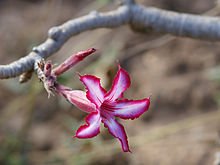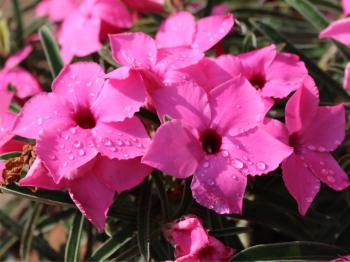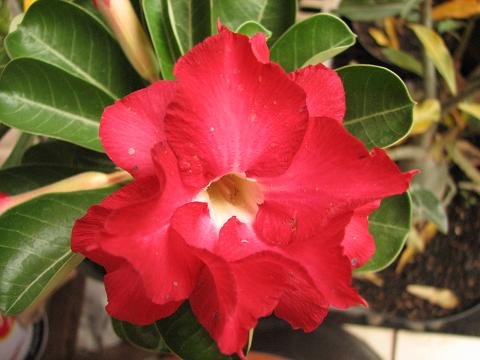What did you know Adenium (Frangipani plants)
Getting to Know Adenium (Frangipani Plants)
Frangipani, Timpani, Pua, and Temple Flower are amongs the common names for Plumeria. Their waxy scented flowers bring an evening tropical fragrance to the garden and outdoor living areas. This is a woody deciduous tree needing careful attention to growing. Source
Frangipani plant is an ornamental plant with the beauty of color and flower patterns are diverse. The name "Cambodia in Indonesia" actually has a distinct characteristic difference between "adenium / kamboja japan" and "kamboja". Adenium leaf morphology is much smaller than frangipani leaves, enlarged adenium roots such as tubers that serve as a place to store water, while the frangipani roots do not have a cob.
Physical form of these two plants is also different, adenium grow small, while frangipani grow high and commonly used as a protective plant. Adenium plants can survive in dry areas, and survive from the stems of plants because it can store water as a reserve of nutrients. Tropical climate like Indonesia is very suitable for cultivation of adenium.
Types Of Adenium
Adenium displays various types ranging from leaf shape, motif, and color of flowers, among them:
Adenium obesium
Scientific classification
Kingdom : Plantae
Clade : Angiosperms
Clade : Eudicots
Clade : Asterids
Order : Gentianales
Family : Apocynaceae
Genus: Adenium
Species: A. obesum
Binomial name
Adenium obesum
(Forssk.) Roem. & Schult. Source
Long leaves with a soft tip, the bone leaves vary widely from the thin to the rough and bright green. Flower-shaped stars, this adenium including plants that diligently flowering.
Adenium multiflorum

Scientific classification
Kingdom: Plantae
(unranked): Angiosperms
(unranked): Eudicots
(unranked): Asterids
Order: Gentianales
Family: Apocynaceae
Genus: Adenium
Species: A. multiflorum
Binomial name
Adenium multiflorum
Klotzsch. Source
Big and wide-shaped, star-shaped flowers, this plant rarely flowering until the age of 4-5 years after that is very industrious flowering.
Adnium swazicum

The leaves are light green to dark green with fluff on the underside of leaves, star-shaped flowers, this plant is easy to grow and easy to grow.
Adenium doxon

This plant arises due to mutation, the likelihood of the trigger is the unequal distribution of nutrient rations. Excessive water stress can cause the same effect if there is a shunt. This opinion is not yet tested is still needed further research. The emergence of the pile of flowers on adenium is still not stable, if digraffting may come out stacked flowers only 50-60% of all the flowers that appear. In addition, not all stacked flowers will bloom in one tree, it could be that most of the flats keep budding.
There are two ways to increase adenium, namely:
- The generative way is to multiply by seed
- The vegetative way is to multiply by cuttings, grafts, and connections.
How to cultivate Adenium?
Generative propagation
- Soak seeds with warm water for 2-4 hours.
- Prepare seedling pot and fill the base with sterefom, charcoal or coral rock. The material serves to keep the drainage so that the media is not inundated with water. High layer of material 5-7 cm. Pot diameter 20 cm enough to sow 100 seeds adenium. Can also be used seed tray, which is a square-shaped seeding with holes 3 cm diameter seed tray is usually used for seeding until the plant is 3 months old.
- Fill the top of the seed tray with the planting medium. Recommended media comparison of fuel husk: poor sand: coco paet: compost.
- Lightly grab the media with water.
- Sow the seeds that have been soaked earlier on the media that have been prepared.
- Then, covered with a layer of media approximately 1 cm thick. Can also seeds are left open until they grow into sprouts. Once the sprouts, newly sprinkled with planting media to support the sprouts can stand upright.
- The surface of the pot is covered with a translucent plastic to avoid excessive evaporation and the media remains wet. The use of transparent plastic facilitates the development of seeds. Usually within 3-7 days the seed has become sprouts.
- After becoming sprout, the seedbed can be placed under the shade with the intensity of 50% sunlight or dried in the morning for 1-2 days in a row.
- Next, put in place enough sunlight like an adult plant. However, the media must be kept in a damp state.
- After the age of 4-6 weeks from seeding, each plant can be moved into a pot with a diameter of 10-12 cm. Planting media used can be mixed with a complete fertilizer with high P levels such as 1-13-25. The dosage of fertilizer is 1 teaspoon for each pot of 10-12 cm (½ liter medium). Furthermore the plant is treated until flowering.
Vegetative propagation
- Cut the stem 10-15 cm long. Leave 2-3 leaves to reduce evaporation. Use a sharp and sterile knife so that the plant is not infected.
- After cutting, dry the stems in the shade for 1-2 hours to dry the stems. The cutting material should not be exposed to water and direct sunlight.
- Dip the cut part with the root stimulant, then dry the air for 1-2 hours. After that, plug the stem cuttings on planting medium as deep as 4-5 cm.
- Flush water equally. Next, place the plants in the shade with low light intensity, about 60-70%.
How to connect (graffting)
- Bottom plant stems are cut to form the letter V
- Prepare the top rods of other types of crops and pointed pieces
- Connect the rootstock and up
- Band boundary with plastic
Each adenium plant requires fertilizer and nutrients. Usually nutrients contained in the planting medium is not complete and can not meet the needs of the plant. Therefore, it needs additional nutrient in the form of fertilizer, the example of fertilizer is commonly used is compost.
Adenium has a mortal enemy that strikes at all stages of growth. Some of them strike from the stadia of the larvae to adulthood resulting in all parts of the plant: roots, tubers, leaves, shoots, flowers are attacked by pests and diseases. As a result, adenium plants do not appear prime, if left over time will die.
Adenium plants do not require excessive water, watering is done with attention to soil moisture. Control moisture by scraping the top soil as deep as 2 cm, if still wet need not be watered.
References
